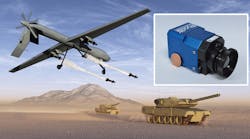Robotic partners such as unmanned aerial vehicles (UAVs) are making battlefield conditions safer for human troops, especially when they can “see” what humans cannot. In the case of the Pyxis infrared (IR) polarimetric camera developed by Polaris Sensor Technologies in partnership with the U.S. Army Combat Capabilities Development Command’s Army Research Laboratory (ARL), the IR camera makes it easier to find targets that may be highly camouflaged in densely cluttered environments. The IR camera uses the unique polarization signatures of different targets to distinguish the polarization signature of man-made objects from natural backgrounds.
“The Pyxis camera offers significant benefits in target detection and clutter suppression over conventional uncooled infrared cameras without any increase in size, weight, or power,” said Dr. David Chenault, president of Polaris Sensor Technologies. The camera was developed by integrating a pixelated polarizing filter into a microbolometer, allowing the camera to differentiate targets from backgrounds even without strong contrasts in the thermal signatures.
“The physics of polarization is complicated, and our software enables the user to quickly and easily explore how signatures are impacted by materials and geometry in the scene,” Chenault said. “The analytical tools in our software makes comparing the performance of image metrics in the polarimetric video easy.” In addition to target detection and surveillance on military UAVs, the Pyxis camera has a long list of possible applications in commercial and industrial markets, such as detecting oil spills at sea and different forms of wildlife in national forests.

